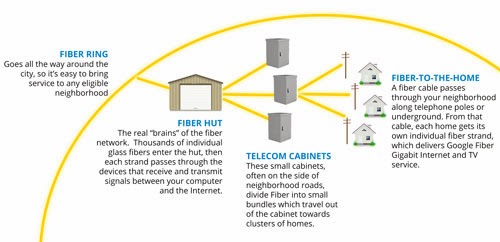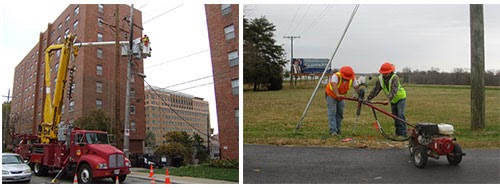Today your Internet and TV service are probably connected to your home via copper wires. This technology has been around for over 100 years, and it just wasn’t built for what we’re trying to use it for today. My job with Google Fiber is to build thousands of miles of brand new fiber-optic cable, which is far better and faster than copper at transmitting information, such as the bits that make up your favorite websites, YouTube videos, video chats, or online games. Fiber-optic cables are made of glass, and they use lasers to transmit information — close to the speed of light! It’s amazing technology, but unfortunately very few homes have direct access to fiber networks today.
That’s where my team comes in. Every day, we’re working to plan and build brand new Google Fiber networks in Kansas City and Austin. There are a few big steps.
Step 1: Figure out where we can put our fiber. We need to build thousands of miles of fiber — but we can’t just put it wherever we want. First, we use the infrastructure data that the city has shared with us to create a base map of where we can build (existing utility poles, conduit) and where we should avoid (water, sewer and electric lines). Then, a team of surveyors and engineers hits the streets to fill in any missing details.
Step 2: Design the network. There are a few basic components to our Fiber networks that we need to design from scratch for every single city. In general, you can think of it as a hub-and-spoke design:
Every mile of this network has to be planned and diagramed, which takes a huge amount of time (imagine planning a network that touches ~30 utility poles per mile, for thousands of miles). We also plan and build backup fiber routes; we want to be ready just in case there's a break in service along any section of our network (it just so happens that squirrels love to chew through fiber lines).
Step 3: Build the network. Only once we have a solid plan — including diagrams of every utility pole our fiber will travel on, detailed maps of where we’ll need to dig up streets to install new conduit, and the specs for every single hut and cabinet — can we get boots on the ground to start building our network. That’s when you’ll start to see crews out in the streets with their boom trucks, boring machines, and rolls of conduit and cables.
In other words, this is a huge undertaking, and we know you might get a bit impatient with us from time to time. We know you want your Google Fiber — please know that we’ve got our teams hard at work to get you connected just as soon as we can.

